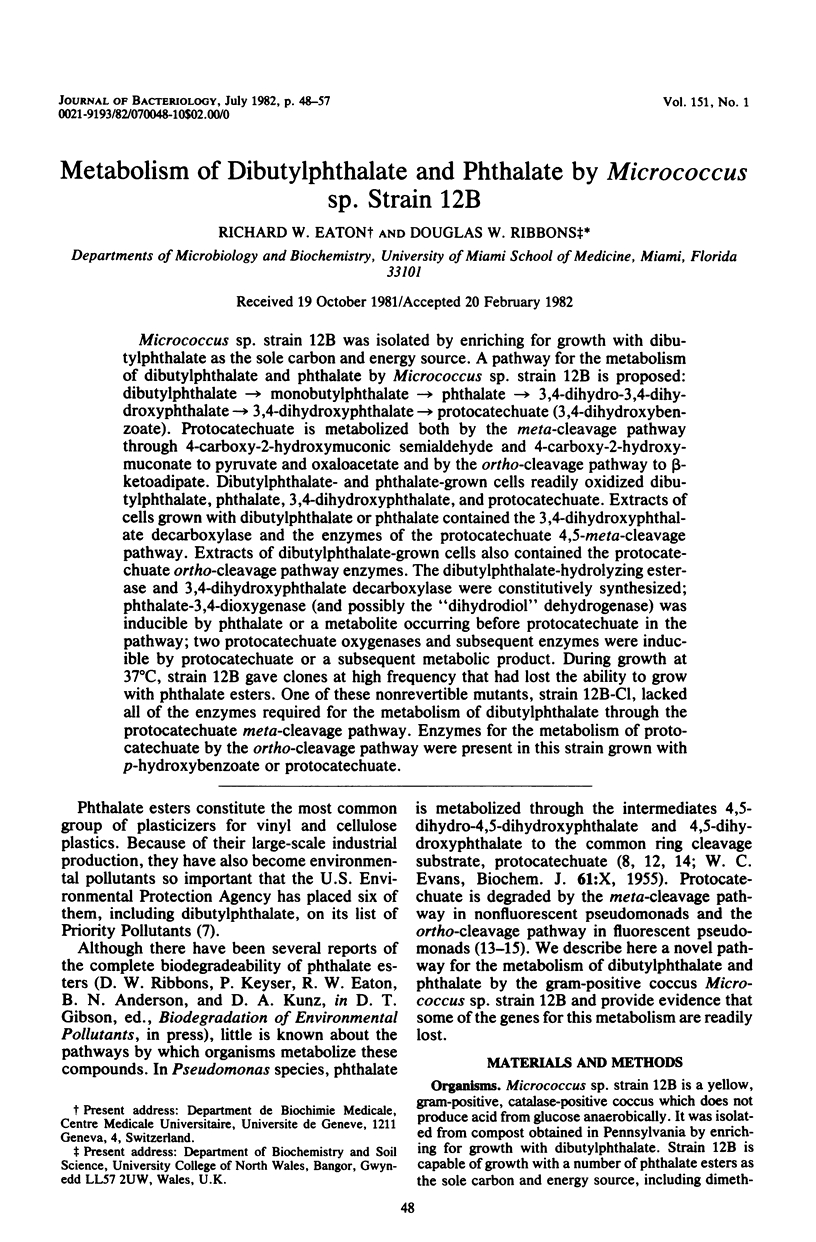Abstract
Micrococcus sp. strain 12B was isolated by enriching for growth with dibutylphthalate as the sole carbon and energy source. A pathway for the metabolism of dibutylphthalate and phthalate by micrococcus sp. strain 12B is proposed: dibutylphthalate leads to monobutylphthalate leads to phthalate leads to 3,4-dihydro-3,4-dihydroxyphthalate leads to 3,4-dihydroxyphthalate leads to protocatechuate (3,4-dihdroxybenzoate). Protocatechuate is metabolized both by the meta-cleavage pathway through 4-carboxy-2-hydroxymuconic semialdehyde and 4-carboxy-2-hydroxymuconate to pyruvate and oxaloacetate and by the ortho-cleavage pathway to beta-ketoadipate. Dibutylphthalate- and phthalate-grown cells readily oxidized dibutylphthalate, phthalate, 3,4-dihydroxyphthalate, and protocatechuate. Extracts of cells grown with dibutylphthalate or phthalate contained the 3,4-dihydroxyphthalate decarboxylase and the enzymes of the protocatechuater 4,5-meta-cleavage pathway. Extracts of dibutylphthalate-grown cells also contained the protocatechuate ortho-cleavage pathway enzymes. The dibutylphthalate-hydrolyzing esterase and 3,4-dihydroxyphthalate decarboxylase were constitutively synthesized; phthalate-3,4-dioxygenase (and possibly the "dihydrodiol" dehydrogenase) was inducible by phthalate or a metabolite occurring before protocatechuate in the pathway; two protocatechuate oxygenases and subsequent enzymes were inducible by protocatechuate or a subsequent metabolic product. During growth at 37 degrees C, strain 12B gave clones at high frequency that had lost the ability to grow with phthalate esters. One of these nonrevertible mutants, strain 12B-Cl, lacked all of the enzymes required for the metabolism of dibutylphthalate through the protocatechuate meta-cleavage pathway. Enzymes for the metabolism of protocatechuate by the ortho-cleavage pathway were present in this strain grown with p-hydroxybenzoate or protocatechuate.
Full text
PDF









Selected References
These references are in PubMed. This may not be the complete list of references from this article.
- Bradford M. M. A rapid and sensitive method for the quantitation of microgram quantities of protein utilizing the principle of protein-dye binding. Anal Biochem. 1976 May 7;72:248–254. doi: 10.1006/abio.1976.9999. [DOI] [PubMed] [Google Scholar]
- Crawford R. L., Bromley J. W., Perkins-Olson P. E. Catabolism of protocatechuate by Bacillus macerans. Appl Environ Microbiol. 1979 Mar;37(3):614–618. doi: 10.1128/aem.37.3.614-618.1979. [DOI] [PMC free article] [PubMed] [Google Scholar]
- Dennis D. A., Chapman P. J., Dagley S. Degradation of protocatechuate in Pseudomonas testosteroni by a pathway involving oxidation of the product of meta-fission. J Bacteriol. 1973 Jan;113(1):521–523. doi: 10.1128/jb.113.1.521-523.1973. [DOI] [PMC free article] [PubMed] [Google Scholar]
- Eaton R. W., Ribbons D. W. Metabolism of dimethylphthalate by Micrococcus sp. strain 12B. J Bacteriol. 1982 Jul;151(1):465–467. doi: 10.1128/jb.151.1.465-467.1982. [DOI] [PMC free article] [PubMed] [Google Scholar]
- Hegeman G. D. The metabolism of p-hydroxybenzoate by Rhodopseudomonas palustris and its regulation. Arch Mikrobiol. 1967;59(1):143–148. doi: 10.1007/BF00406325. [DOI] [PubMed] [Google Scholar]
- Keyser P., Pujar B. G., Eaton R. W., Ribbons D. W. Biodegradation of the phthalates and their esters by bacteria. Environ Health Perspect. 1976 Dec;18:159–166. doi: 10.1289/ehp.7618159. [DOI] [PMC free article] [PubMed] [Google Scholar]
- MACDONALD D. L., STANIER R. Y., INGRAHAM J. L. The enzymatic formation of beta-carboxymuconic acid. J Biol Chem. 1954 Oct;210(2):809–820. [PubMed] [Google Scholar]
- Maruyama K., Ariga N., Tsuda M., Deguchi K. Purification and properties of alpha-hydroxy-gamma-carboxymuconic epsilon-semialdehyde dehydrogenase. J Biochem. 1978 Apr;83(4):1125–1134. doi: 10.1093/oxfordjournals.jbchem.a132002. [DOI] [PubMed] [Google Scholar]
- Maruyama K. Isolation and identification of the reaction product of alpha-hydroxy-gamma-carboxymuconic epsilon-semialdehyde dehydrogenase. J Biochem. 1979 Dec;86(6):1671–1677. doi: 10.1093/oxfordjournals.jbchem.a132687. [DOI] [PubMed] [Google Scholar]
- Nakazawa T., Hayashi E. Phthalate and 4-hydroxyphthalate metabolism in Pseudomonas testosteroni: purification and properties of 4,5-dihydroxyphthalate decarboxylase. Appl Environ Microbiol. 1978 Aug;36(2):264–269. doi: 10.1128/aem.36.2.264-269.1978. [DOI] [PMC free article] [PubMed] [Google Scholar]
- Nakazawa T., Hayashi E. Phthalate metabolism in Pseudomonas testosteroni: accumulation of 4,5-dihydroxyphthalate by a mutant strain. J Bacteriol. 1977 Jul;131(1):42–48. doi: 10.1128/jb.131.1.42-48.1977. [DOI] [PMC free article] [PubMed] [Google Scholar]
- RIBBONS D. W., EVANS W. C. Oxidative metabolism of protocatechuic acid by certain soil pseudomonads: a new ring-fission mechanism. Biochem J. 1962 Jun;83:482–492. doi: 10.1042/bj0830482. [DOI] [PMC free article] [PubMed] [Google Scholar]
- Ribbons D. W., Evans W. C. Oxidative metabolism of phthalic acid by soil pseudomonads. Biochem J. 1960 Aug;76(2):310–318. doi: 10.1042/bj0760310. [DOI] [PMC free article] [PubMed] [Google Scholar]
- Tack B. F., Chapman P. J., Dagley S. Metabolism of gallic acid and syringic acid by Pseudomonas putida. J Biol Chem. 1972 Oct 25;247(20):6438–6443. [PubMed] [Google Scholar]


